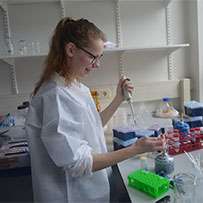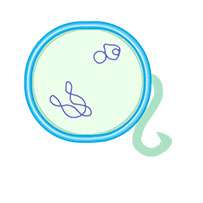Students develop bacteria cells capable of independently producing a bio-lens

Students at TU Delft are using the latest technology to develop bacteria cells that can independently produce a bio-lens. The DNA in the bacteria cells is processed to enable the cells to form a micro-lens independently. The lenses, that can be used for microscopy, for example, also have the potential for making solar cells of the future more efficient. With their bio-lenses, the team of students are hoping for victory at the international student 'iGEM' (International Genetically Engineered Machine) competition held in Boston from 27 to 31 October. In the competition, students attempt to solve problems in society with the aid of synthetic biology.
Low-cost lenses
To make a bio-lens, the DNA in the bacteria cells is processed, enabling it to produce new proteins. The protein, similar to that produced by a sea sponge, is used to build a thin layer of glass. The bacteria cell creates the biological lens with this piece of glass. It is the first time that bacteria cells have produced a lens independently.
The lenses are significantly more environmentally-friendly than existing micro-lenses used in microscopes, for example. Conventional lenses are produced at high temperature, low-pressure and in a high acid environment. The process also releases chemicals. The iGEM student team's bio-lenses are created at lower temperatures and standard air pressure. This makes them better for the environment and cheaper to make, since much less energy is required to achieve the necessary conditions.
A potential use for micro-lenses is on solar panels. A research group from France has already shown that existing industrial micro-lenses can improve the efficiency of solar cells by up to 50%. This is because the lenses enable more light to be absorbed by the solar cells. However, these micro-lenses are far too expensive to make, which is why they are not yet used on solar cells. This could be achievable using the bio-lenses developed by the Delft iGEM team. They are attempting to use a layer of their cells to improve the efficiency of solar panels.

Existing industrial lenses are used for various applications, including microscopy. The bio-lenses now developed also have the potential for improving research techniques for cellular diseases, including those affecting the brain. The bio-lenses form a collection of lenses, enabling them to absorb more light together than a single large lens can. This makes it easier to detect details within cells, which means these diseases are also easier to detect. The method used by the iGEM team could in the future be used to produce low-cost lenses – for photography lens production, for example.
The TU Delft iGEM team, made up of 10 students from various academic backgrounds, is competing In Boston against 300 international teams from across the world. iGEM is a competition to solve problems in society with the help of synthetic biology: processing micro-organisms. Giving bacteria cells a special function is one way of doing this. For example, bacteria cells can be used to transmit an electric signal to indicate whether or not a landmine is located on a piece of land, as was demonstrated by the 2014 TU Delft IGEM team.
Provided by Delft University of Technology




















